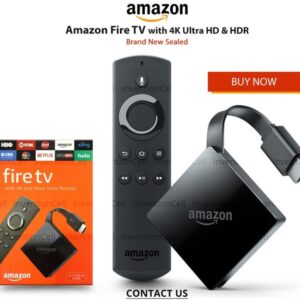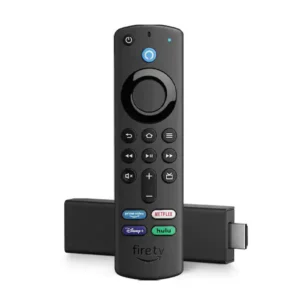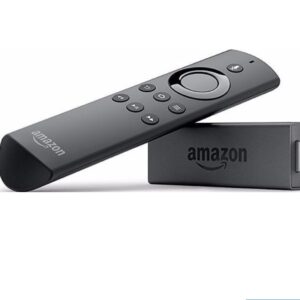Amazon’s third-generation Fire TV Stick is nearly identical to its predecessor, just a bit faster and equipped with a new remote, which is enough to preserve its status as the best media streamer for 1080p TVs.
Pros
- Affordable
- Faster processor than previous model
Includes remote with microphone, TV controls, and dedicated service buttons ,
| Resolution | 1080p |
| HDR | HDR10 |
| Platform | Amazon Fire TV Store |
| Built-In Voice Assistant | Amazon Alexa , We first reviewed Amazon’s third-generation Fire TV Stick late last year. This year, it stealthily released a revised version, updating the remote while keeping the itself the same. It’s still $39.99 and loaded with useful features like Amazon Alexa voice control; the main differences are a new remote with a few additional buttons, and a new Fire TV interface. The third-gen Fire TV Stick remains the best 1080p media streamer available, and an ideal way to add smart TV functionality to older TVs, earning it our Editors’ Choice award.
Fire TV Stick Design and HardwarePhysically, the third-generation Fire TV Stick is identical to the Fire TV Stick Lite and the Fire TV Stick 4K, which, in turn, were largely unchanged from previous Fire TV Sticks in design. It’s a simple 3.4-by-1.2-inch (HW) black plastic rectangle with an HDMI plug sticking out of one end. It’s completely unadorned, except for an embossed Amazon logo on the top and a micro USB port on the side. The micro USB port connects to the included wall adapter for power, and can be used with Amazon’s optional $15 Ethernet adapter if you want to use a wired network connection. A short (only a few inches) HDMI extender is included if there isn’t enough room on the back of your TV to plug the Fire TV Stick directly into an HDMI port. Internally, the third-gen Fire TV Stick seems to be almost the exact same device as the Fire TV Stick Lite. It’s a 1080p media streamer that supports high dynamic range (HDR) content in HDR10, HDR10+, and hybrid log gamma (HLG). According to Amazon, it’s 50% more powerful than the previous (second-generation) Fire TV Stick, the same claim made about the Fire TV Stick Lite. The only difference between the two devices, aside from their remotes, is that the Fire TV Stick can output Dolby Atmos audio if your TV, soundbar, or surround sound system can handle it. The Fire TV Stick Lite can’t. The remote is the biggest change on the new Fire TV. It’s the third generation of Amazon’s Alexa voice remote, with a slightly tweaked design and a bit more functionality. It’s still a thin black wand with slightly rounded ends, and is the exact same size and shape as the previous Alexa voice remote. It also still has the same prominent circular navigation pad, pinhole microphone for using Alexa (though the Alexa button is now a blue Alexa logo instead of a black microphone), playback controls, and TV power and volume controls. The main change here is the addition of four dedicated service buttons below the TV controls for Amazon Prime Video, Disney+, Hulu, and Netflix. They let you jump straight into those apps, which is useful but not exactly vital when the apps are easy to find on the home screen. The microphone for Alexa and the TV controls for adjusting volume are the most vital parts of the remote, and they carry over from the previous model. The Fire TV Stick Lite, by comparison, has the Alexa microphone but completely lacks TV controls or dedicated service buttons. Fire TV and AlexaAmazon has made significant interface changes to its Fire TV platform over time, but it remains a powerful, feature-filled system, and the new Fire TV Stick lets you do the same things as the previous Fire TV Stick, the Fire TV Stick 4K, and the Fire TV Stick Lite. Most major streaming services are available, including Amazon Prime Video, Apple TV, Disney+, HBO Max, Hulu, Netflix, Twitch, and YouTube. Fire TV also has thousands of apps and services covering a wide variety of subjects, and you can stream games on it with Amazon Luna if your connection is fast enough (we recommend getting a Luna Controller to go with it). For streaming media or mirroring screens from local devices, the Fire TV platform is a bit limited. You can stream from a PC or mobile device with WiDi or MiraCast, but that’s about it. You won’t find Google Cast like on the Chromecast or Apple AirPlay like on Roku devices, which respectively make sharing what’s on your Android phone or iPhone simple and convenient. Of course, Amazon Alexa is here, so you can get all of the benefits of Amazon’s voice assistant by holding the Alexa button and speaking into the remote. You can ask Alexa to search for movies and TV shows, open different apps, and play music from Amazon Music, Spotify, or iHeartRadio. You can also ask Alexa for general information like the weather and sports scores, with the answers popping up on your TV screen as well as through its speakers. Alexa also lets you control smart home devices with your voice. It supports all major smart lighting, locks, and thermostat brands, and can even bring up live feeds from compatible home security or doorbell cameras. Amazon redesigned the Fire TV interface earlier this year (which applies to all Fire TV devices). The home screen feels a bit more cluttered than the previous menu layout, and it tends to nudge you even more toward Amazon’s own services for media. Of course, layout and aesthetics are a matter of personal taste, and you might like the new Fire TV experience more than I do. Fire TV Stick PerformanceThe new Fire TV interface seems to be a bit more resource-intensive than the previous model, based on how responsive it is on the Fire TV Stick. The menus can stutter occasionally, and YouTube once crashed to the main menu after freezing for a few seconds. It also takes several seconds to return to the home screen from any app. Curiously, the third-gen Fire TV Stick performed a bit more smoothly in testing than the Fire TV Stick Lite, which has the same processing power. Once your apps are open or your content is loaded, the Fire TV Stick generally works very well. I had no issue browsing through the Netflix and YouTube apps (aside from that one crash), and of course looking through Amazon Prime Video is fluid because it’s built directly into the main interface. Video loaded quickly from different apps, and the picture looks as good as 1080p output can; if you want 4K, you need to get the Fire TV Stick 4K. , Still the Best 1080p StreamerThe third-gen Amazon Fire TV Stick remains the best option for adding streaming media to your 1080p TV. You get plenty of streaming apps and services, plus Amazon Alexa, for just $40. It’s slightly more expensive than the Fire TV Stick Lite, but the addition of TV volume controls is worth the extra $10. If you have a 4K TV and want to add streaming and a voice assistant to it, you should seriously consider the Fire TV Stick 4K or the Chromecast With Google TV, because a native 4K picture simply looks better on a 4K TV than an upconverted 1080p picture. Still, if you’re sticking with an older TV and simply want to breathe new life into it, the third-gen Fire TV Stick is our Editors’ Choice. Pros
Includes remote with microphone, TV controls, and dedicated service buttons |







admin –
Great Product